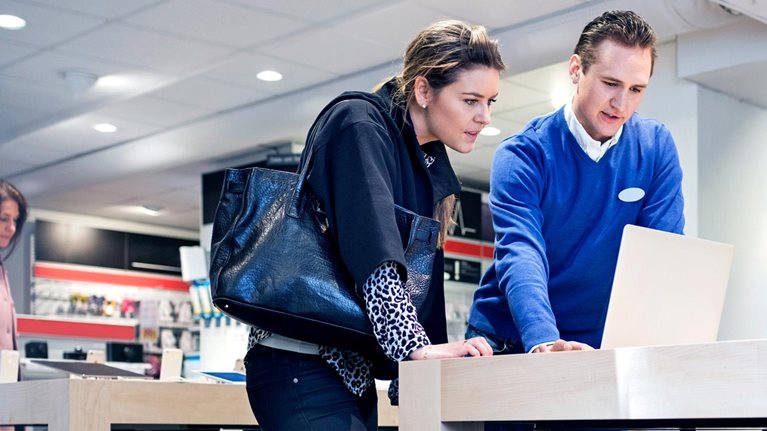In this edition of Author Talks, McKinsey Global Publishing’s Alexandra Mondalek chats with Philip Kotler, professor emeritus of marketing at Northwestern University’s Kellogg School of Management, and Giuseppe Stigliano, global CEO of Spring Studios, about their new book. In Redefining Retail: 10 Guiding Principles for a Post-Digital World (Wiley, January 2024), the authors draw on more than 50 years of research to discuss the evolution of retail from the physical world to the post-digital age. They also outline a plan for addressing the transformation reshaping the industry. An edited version of the conversation follows.
Why did you write Redefining Retail?
Philip Kotler: There’s a perfect storm going on in retailing. Malls are closing. Previously, there were 2,500 shopping malls in the United States, and now there are roughly 700. That number will likely decrease to 200.
Do we need stores anymore if I can go to Amazon and get anything shipped to me? Shopping is becoming more of a cost rather than a pleasure. Disintermediation, disruption, and lots of things happening in retailing led to our interest in approaching the topic through a fresh lens.
Giuseppe Stigliano: During COVID, a huge portion of the global population, including segments that were not used to paying online, placed their orders through a website. They were forced to familiarize themselves with this technology, which became the norm. The combination of the trends described by Professor Kotler, along with the “digital alphabetization” that happened during COVID, led us to where we are now. We saw the need for a new book to present some of the research on this topic.
Philip Kotler: We have already moved into the digital age, but that isn’t the end. We are moving into the post-digital age, which means we are not only in a physical world, we are also operating in the digital world that exists now—a virtual world. I’ve been writing a little bit about the metaverse, or the equivalent. There, we can do things virtually that were not possible before. Technology underlies all of these changes. Using them in, and defining them for, retailing is very important.
We can do things virtually that were not possible before. Technology underlies these changes. Using them in, and defining them for, retailing is very important.
What surprised you when you were writing the book?
Giuseppe Stigliano: What surprised us is the fact that there was a lot of alignment in terms of the issues, although the answers, ideas, and plans varied significantly. The variation is attributed not only to the nuances of the different industries and geographies, but also to the fact that this represents a paradigm change.
It’s an exponential transformation, rather than an evolution. What surprised us was the common understanding that something needed to be done. The question is, “what?” So we aimed to provide new guiding principles in the book.
Philip Kotler: Almost anyone can be a retailer. Any innovative person can start selling items. For example, in the early days of retail, someone sat down on the street with goods and flagged me when I passed by. Then we had an interaction. Right now, people could approach me, not as existing “stores,” but because they have something to sell me. Our book does a very good job of defining better how those same people could venture into established retailing.
What informs a consumer brand’s decision to go direct to consumer versus working with a retailer?
Giuseppe Stigliano: We believe that even the “influencers” in the fashion world, for example, are retailers to some extent. They curate a selection of all the possible products that one can buy and have interest in. They deal with what we define as the “paradox of choice.” This refers to what consumers experience because they can buy anything, at any time, no matter where the seller is located. This creates the paradox of choice.
The choice is overwhelming. In some cases, influencers are the intermediaries. They curate a selection of products, and they offer that selection to their followers. This is exactly what was done in the past by store owners. Yet this is an example of new-generation retailers, where the influencers are between supply and demand. Of course, the same could be done by an e-commerce website, as long as it’s about curation—select goods—as opposed to trying to sell anything to everyone.
The industry, the competitive landscape, the digital alphabetization of the audience—how much the audience is familiar with technology and with social media and new apps like TikTok—create variation. That makes it very hard to build a standard framework that is valid for everyone. The saying “one size fits all” is not applicable in this case.
The industry, the competitive landscape, the digital alphabetization of the audience, create variation. That makes it hard to build a standard framework.
There are some steps that everyone should follow. The first one is understanding your customer. Professor Kotler wrote a lot about the fact that marketing is not only about promotion. Rather, marketing is needed to simplify the relationship between supply and demand. Ideally, marketing is a way to fine-tune the supply so that it can meet the demand. Hopefully, this is also a good way to reduce waste if the fine-tuning is correct.
The starting point is understanding the customer. We have plenty of data available today, but that access provides a great opportunity, as well as a potential challenge. Assuming that you are an established player, the moment you decide to bypass your former business partners’ retailers, or even the B2B partners that you have along the value chain, you incur any number of challenges.
You need to figure out the financial implications, because you need to make investments, as well as plan for operations and logistics. The whole idea was to be doing multichannel work.
It was originally one channel, one company—a store, for example. Then we moved into multichannel, and now we’re moving from multichannel as well. Next is omnichannel, which is to make sure that all the channels embrace the brand and deliver value in the same way.
But omnichannel is still facing the paradox of choice. There are so many ways to move. So we are now moving to something called optichanneling, where we don’t want a consumer to switch endlessly into all the channels that we offer. We want to optimize how that consumer chooses the optimum way to get to what she or he wants to solve the problem.
What is the difference between omnichannel and optichannel?
Giuseppe Stigliano: Multichannel means that you put the focus on trying to develop as many channels as possible. That way, no matter what the consumer wants to use, whether it’s a communication channel or a sales channel, he or she can find you.
For multichannel, the focus is on the quantity and trying to be available. Yet the flip side of trying to be open or to be so available is that you create a lot of friction.
Also, it becomes very hard to be consistent. Perhaps you have a call center. The call center representatives say one thing. Yet when customers move from that channel to another channel— the physical store, for example—they don’t find the product they want.
Then those customers complain and say, “Well, I called, and the call center told me that I could come and find the product.” Customers wind up getting answers like, “Yeah, but that is operated by a third party. It’s not part of our organization.”
Customers don’t necessarily know exactly what happens here. They know that they don’t like these frictions, and, frankly, they don’t tolerate them anymore. Those experiences led to the next development and people who said, “We need omnichannel. We need to make sure that we develop the channels around the customer and that everything is seamlessly integrated.”
In the multichannel, the focus was on the quantity. On the omnichannel, the focus is on the seamless integration of all available channels, which is great. They evolve and change so fast that in the time it takes for you to develop an omnichannel and try to reduce the friction, there’s yet another development. At some point, you realize that there are new channels, and to maintain the old channels and sponsor the content, you need a huge media budget.
At some point, the focus should shift from the seamless integration of all available channels to an optimization of the available channels. This involves trying to decide which channels are more relevant to your consumers, considering a specific geography, industry, relationship they have with the brand, the characteristics of the product, and other attributes.
The focus should shift from the seamless integration of all available channels to an optimization of the available channels.
You might end up realizing that there are sectors in which people prefer to do what we call “webrooming.” This means they browse online, develop an idea of what they want, then go to a physical store because they want to touch the fabric or try on the product.
They still need an experience from the past. But it’s important to note that when they visit the store, they know everything about the product already. In some cases, they know more than salespeople with whom they interact because they have spent a lot of time online developing an idea of what to buy.
Optimizing the channel means taking into consideration what consumers actually do when it comes to your category and product. From there, it means building an infrastructure and ecosystem, then deciding how to allocate the budget in a way that resonates with your understanding of the consumer.
What are the implications of the blurred lines between ‘B2B’ and ‘B2C’ retail?
Philip Kotler: Some business-to-business retailers are now moving into business-to-consumer retail for certain kinds of products that they can make additional money selling more directly. They have to be very careful. They don’t want their B2B customers, to whom they’re always selling, to be upset that the “B” company took some initiatives to also reach the ultimate customer.
In B2B, you want to leave it to the other “B” to contact customers, and you don’t want to go against them. You want to use them as the channel and not compete against them by going directly with that same product to ultimate customers. There are tempting business opportunities for B2B companies to find certain products they can sell more directly, hopefully without hurting their established B2B customers.
Giuseppe Stigliano: One of the reasons the lines are blurring is what we have described before as disintermediation, or the opportunity to bypass intermediaries. Everybody can be a retailer.
What does it mean to be ‘humbitious’?
Giuseppe Stigliano: It is a portmanteau of two words, “humility” and “ambition.” This is one of the guiding principles that should inspire managers and leaders today. Since the world is changing at the speed of an algorithm, leaders and managers need to accept that experience is very important, but knowledge—knowledge about technology, innovation, artificial intelligence, the metaverse—is very relevant today.
Whatever you learned becomes obsolete very fast—faster than in the past. So “humbition” means being humble enough to accept that what got you here won’t get you there. Yes, your experience is important, but you cannot necessarily rely on the past to build a future.
Blending this with the ambition to write the rules of the game is ideal, because the opportunity in a phase in which there is a paradigm shift is a white canvas. There is a great opportunity for established players, incumbents, newcomers, start-ups to actually write the rules of the game—of a new game.
What is important to emphasize about retail’s next chapter?
Giuseppe Stigliano: Let’s assume that we are in the post-digital phase where hype meets reality. Direct-to-consumer [D2C] retail is an opportunity, because the technology allows you to do it. But pay attention to the implications. Rather than jumping on the bandwagon, carefully assess D2C opportunities and trends.
E-commerce is a great opportunity, but for some brands that focus more on the quality of the customer experience, perhaps they want to be very exclusive. In those cases, it’s not necessarily an opportunity, because it can dilute the brand. When we refer to “post-digital,” it’s a stage of maturity of the digital era in which we have to find our way to find an appropriate balance.
The customer journey is something that we’ve noticed talking with managers. Many companies, not the digital natives, but the incumbents, or “the digital immigrants,” as we define them, were struggling. Digital immigrants were already struggling with the customer journey, becoming “phygital,” or a hybrid of “physical” and “digital.” When you add the third dimension, or the virtual, this becomes quite complicated for them.
Now we’re talking about future interactions with digital and physical touchpoints of a consumer, a perspective consumer, or client, who starts the relationship with the brand in a virtual world. This is something completely new. That’s why we define this customer journey as three dimensional. We call it a three-dimensional customer.



